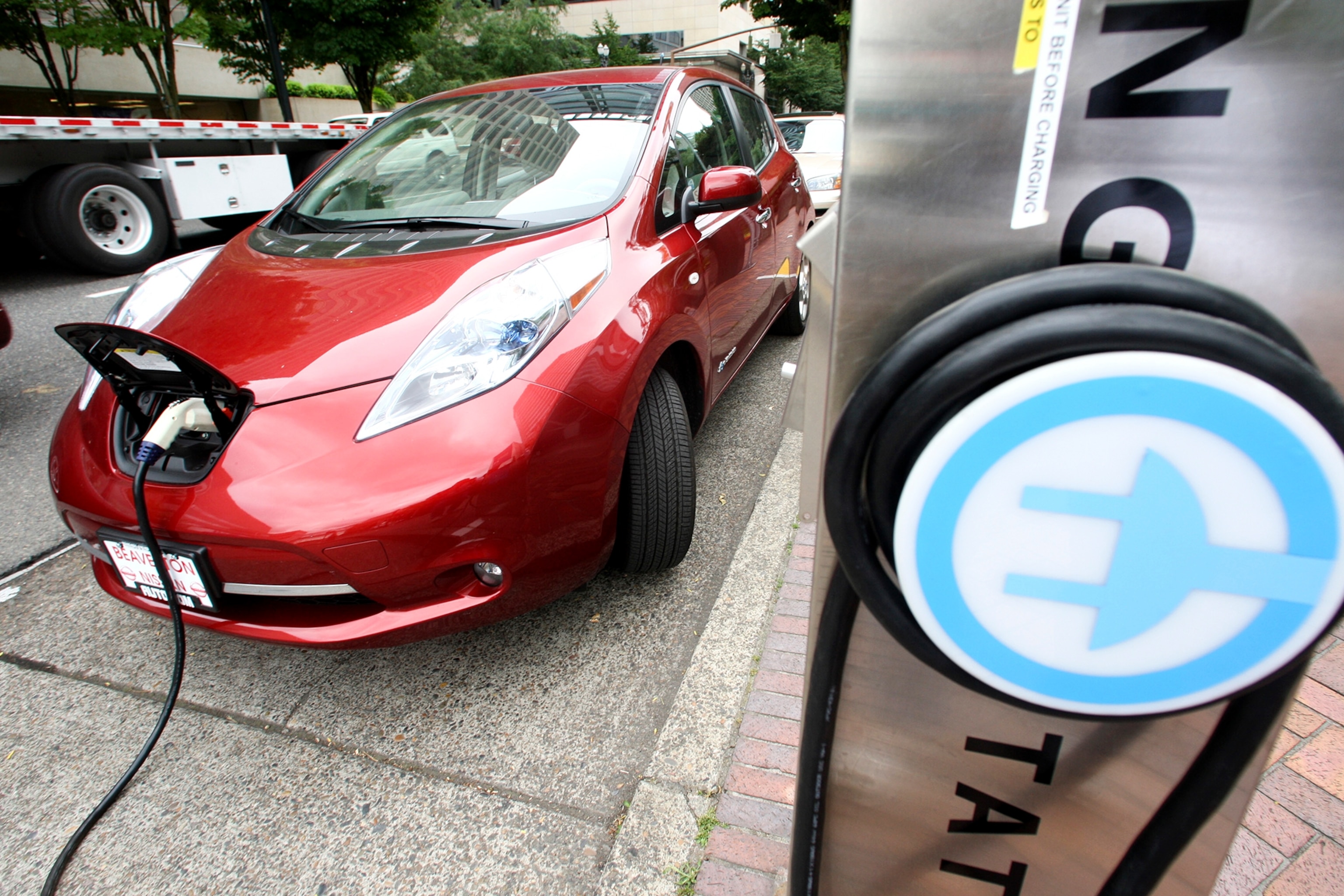
Electric Cars Alone Won’t Drive a Drop in U.S. Emissions: Study
Electric cars alone won’t yield needed cuts in greenhouse gas, new research says. Policymakers need to cut carbon throughout the economy, especially from power plants.
Electric cars can help limit reliance on imported oil and take a bite out of air pollution from urban traffic jams. But as sure-fire ammunition against climate change, a new study finds, they come up short.
The study attempted to take a big-picture view, analyzing the ripple effects of electric vehicles on the U.S. energy system, including possible changes in emissions of key air pollutants like heat-trapping carbon dioxide. The team of researchers, led by Joseph DeCarolis, assistant professor of civil, construction, and environmental engineering at North Carolina State University, created a model to look at the complex interplay among fuel prices, battery costs, government policies, and adoption of electric cars in the coming decades. (See related quiz: What You Don't Know About Cars and Fuel.)
The team modeled 108 scenarios, calculating not only future levels of CO2 expected to spew from tailpipes, but also emissions of sulfur dioxide and nitrogen oxides from factories, power plants, and other sources. In a paper published in the peer-reviewed journal Environmental Science and Technology, the team reported that even in scenarios that yield the highest levels of EV deployment (high oil prices, low battery costs), plug-ins and hybrids would make up no more than 42 percent of all U.S. passenger vehicles in 2050 and would reduce overall emissions by a slim margin. (See related: "Pictures: Cars That Fired Our Love-Hate Relationship With Fuel.")
The new model, developed and refined over nearly four years, comes at a time of rising stakes for understanding just how electric vehicles are likely to affect future emissions. Worldwide, plug-in vehicle production is expected to rise 67 percent this year to more than 403,000 cars, according to the latest forecasts from IHS Automotive. In China, the government announced plans this month to extend subsidies for electric cars as part of a larger effort to address air pollution so severe in some cities that they have prompted emergency measures to tackle the problem. (See related, "Harbin Smog Crisis Highlights China's Coal Problem," and "China's Electric Car Drive: Impressive, But Not Enough.")
But simply put, the North Carolina researchers concluded that electric cars have little ability to make a dent in overall emissions on their own.
"It's possible that the emissions benefits won't materialize under some future conditions," DeCarolis said. "This should hardly be controversial."
Some EV advocates are concerned that the new study might be misinterpreted, and used as ammunition against policies to encourage electrification of transportation. But they generally agree that efforts to cut vehicle emissions through deployment of cars have to go hand-in-hand with other policies to cut greenhouse gases, most notably, cutting emissions from power plants.
Only One Slice of the Pie
A key reason that EVs can only go so far as a solution is because passenger cars and light trucks contribute only about one-fifth of U.S. greenhouse gas emissions. So even if that one slice of the pie were eliminated (and carbon emissions from cars and light trucks dropped to zero), four slices would remain and the big carbon producers would press on. Also, tailpipe emissions don't tell the whole story: If the power grid is dirty enough, then charging an electric car can be more polluting than a fuel-efficient gas car.
The benefits of electric vehicles vary from place to place, season to season, and even time of day, depending on the percentages of electricity produced from zero-emission sources like wind, solar, hydropower, and nuclear, versus coal or natural gas.
The Union of Concerned Scientists (UCS) has made essentially the same point in its research on EV emissions. But Dave Reichmuth, a senior engineer in UCS's Clean Vehicles Program points out that charging and driving an electric car anywhere in the United States today produces fewer greenhouse gas emissions overall than an average compact gas vehicle.
Still, Reichmuth, who was not involved in the new study, agreed with the North Carolina researchers' point that EVs cannot be considered in isolation. "We know that lower battery costs lead to increased use [of electric vehicles], and cleaner electricity increases the benefits," he said. "It's important to look at electric vehicles as one important part of solutions" to address greenhouse gas emissions, along with biofuels, more efficient gas cars, fuel cell vehicles, and cleaner electricity. (See related: "Pictures: Seven Ingredients for Better Electric Car Batteries.")
But in reality, Reichmuth said, federal and state governments are putting into place multiple policies that can function in tandem to boost the benefits of EVs. "In California, we have a renewable portfolio standard for our electric grid, and a number of policies for vehicles," he said. "All of those policies work together."
The Consumer Variable
The North Carolina researchers modeled EV emissions under two potential U.S. policies: a renewable energy portfolio standard and a cap on carbon emissions. But there are variables too uncertain to model, including, notably, consumer choice. "Strong and persistent reluctance on the part of consumers," the researchers write, could "dampen or eliminate" the adoption trends predicted in their scenarios.
Even less clear is how advances outside the battery itself—weight reductions and efficiency improvements, for example—might diminish the influence of battery costs by making it possible for smaller batteries to power longer trips. (See related "Quiz: What You Don't Know About Batteries.") This is an important factor, given that consumers are likely, according to the researchers, to base decisions about which car to buy largely on the cost-effectiveness of one technology relative to another.
In the United States, fuel economy standards set to phase in from 2016 demand that automakers slash greenhouse gas emissions from cars and trucks by half by the 2025 model year—an achievement that industry experts say will require some use of electric drive. (See related: "Pictures: A Rare Look Inside Carmakers' Drive for 55 MPG.") And current U.S. policies, such as tax credits of up to $7,500 for new plug-in vehicle purchases and a pledge to see one million all-electric cars deployed by 2015, are meant to promote adoption of electric cars.
But ultimately, if the goal is to reduce overall emissions, the study authors write, "it is not enough simply to incentivize the purchase of [electric vehicles] and wait for emissions benefits to accrue." They urge policymakers to be mindful of "evolving changes in the broader energy system" over time, noting that the largest and most consistent drop in emissions of carbon, sulfur dioxide, and nitrogen oxides across the dozens of scenarios tested came from a federal mandate to reduce carbon emissions nationwide.
Cleaner electricity can also reduce emissions, including those from electric vehicle charging, and the North Carolina team sees promise in a carbon pollution standard slated for proposal in 2014 that would seek to limit emissions from existing power plants. (See related, "New U.S. Limits on Power Plants: Five Points.")
"I think the take-home point is that the future is fraught with uncertainty, so simple policy actions such as tax credits for alternative vehicles do not necessarily lead to the desired outcome," DeCarolis said. "The conclusion should certainly not be that electric drive vehicles are bad for the environment."
This story is part of a special series that explores energy issues. For more, visit The Great Energy Challenge.








